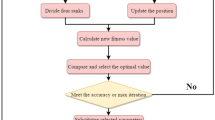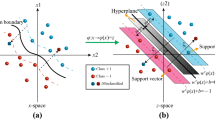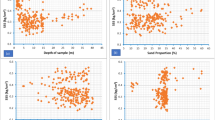Abstract
Liquefaction has caused many catastrophes during earthquakes in the past. When an earthquake is occurring, saturated granular soils may be subjected to the liquefaction phenomenon that can result in significant hazards. Therefore, a valid and reliable prediction of soil liquefaction potential is of high importance, especially when designing civil engineering projects. This study developed the least squares support vector machine (LSSVM) and radial basis function neural network (RBFNN) in combination with the optimization algorithms, i.e., the grey wolves optimization (GWO), differential evolution (DE), and genetic algorithm (GA) to predict the soil liquefaction potential. Afterwards, statistical scores such as root mean square error were applied to evaluate the developed models. The computational results showed that the proposed RBFNN-GWO and LSSVM-GWO, with Coefficient of Determination (R2) = 1 and Root Mean Square Error (RMSE) = 0, produced better results than other models proposed previously in the literature for the prediction of the soil liquefaction potential. It is an efficient and effective alternative for the soil liquefaction potential prediction. Furthermore, the results of this study confirmed the effectiveness of the GWO algorithm in training the RBFNN and LSSVM models. According to sensitivity analysis results, the cyclic stress ratio was also found as the most effective parameter on the soil liquefaction in the studied case.





Similar content being viewed by others
References
Xue XH, Yang XG (2013) Application of the adaptive neuro-fuzzy inference system for prediction of soil liquefaction. Nat Hazards 67:901–917
Xue XH, Yang XG (2016) Seismic liquefaction potential assessed by support vector machines approaches. Bull Eng Geol Environ 75:153–162
Sami M, de Patrick B (2005) Minimum principle and related numerical scheme for simulating initial flow and subsequent propagation of liquefied ground. Int J Numer Anal Methods Geomech 29:1065–1086
Huang Y, Yu M (2013) Review of soil liquefaction characteristics during major earthquakes of the twenty-first century. Nat Hazards 65:2375–2384
Zhang W, Goh ATC, Zhang Y, Chen Y, Xiao Y (2015) Assessment of soil liquefaction based on capacity energy concept and multivariate adaptive regression splines. Eng Geol 188:29–37
Chen G, Xu L, Kong M, Li X (2015) Calibration of a CRR model based on an expanded SPT-based database for assessing soil liquefaction potential. Eng Geol 196:305–312
Yang Y, Chen L, Sun R, Chen Y, Wang W (2017) A depth-consistent SPT-based empirical equation for evaluating sand liquefaction. Eng Geol 221:41–49
Pei X, Zhang X, Guo B, Wang G, Zhang F (2017) Experimental case study of seismically induced loess liquefaction and landslide. Eng Geol 223:23–30
Kayabasi A, Gokceoglu C (2018) Liquefaction potential assessment of a region using different techniques (Tepebasi, Eskişehir, Turkey). Eng Geol 246:139–161
Chen J, O-tani H, Takeyama T, Oishi S, Hori M (2019) Toward a numerical-simulation-based liquefaction hazard assessment for urban regions using high-performance computing. Eng Geol 258:105153
Huang Y, Wen Z, Wang L, Zhu C (2019) Centrifuge testing of liquefaction mitigation effectiveness on sand foundations treated with nanoparticles. Eng Geol 249:249–256
Hu J, Liu H (2019) Bayesian network models for probabilistic evaluation of earthquake-induced liquefaction based on CPT and Vs databases. Eng Geol 254:76–88
Hu J, Liu H (2019) Identification of ground motion intensity measure and its application for predicting soil liquefaction potential based on the Bayesian network method. Eng Geol 248:34–49
Huang Y, Jiang XM (2010) Field-observed phenomena of seismic liquefaction and subsidence during the 2008 Wenchuan earthquake in China. Nat Hazards 54:839–850
Robertson PK, Wride CE (1998) Evaluating cyclic liquefaction potential using the cone penetration test. Can Geotech J 35(3):442–459
Juang CH, Yuan HM, Lee DH, Lin PS (2003) Simplified cone penetration test-based method for evaluating liquefaction resistance of soils. J Geotech Geoenviron Eng 129(11):66–80
Mahesh P (2006) Support vector machines-based modelling of seismic liquefaction potential. Int J Numer Anal Methods Geomech 30:983–996
Maria JS (2011) Applying artificial neural networks for analysis of geotechnical problems. Comput Assist Mech Eng Sci 18:231–241
Samui P, Sitharam TG (2011) Machine learning modelling for prediction soil liquefaction susceptibility. Nat Hazards Earth Syst Sci 11:1–9
Mert T (2013) A comparative study on computer aided liquefaction analysis methods. Int J Hous Sci 37(2):121–135
Erzin Y, Ecemis N (2015) The use of neural networks for CPT-based liquefaction screening. Bull Eng Geol Environ 74:103–116
Abbaszadeh Shahri A (2016) Assessment and prediction of liquefaction potential using different artificial neural network models: A case study. Geotech Geol Eng 34:807–815
Xue XH, Liu E (2017) Seismic liquefaction potential assessed by neural networks. Environ Earth Sci 76:192
Fikret Kurnaz T, Kaya Y (2019) SPT-based liquefaction assessment with a novel ensemble model based on GMDH-type neural network. Arab J Geosci 12:456
Sabbar AS, Chegenizadeh A, Nikraz H (2019) Prediction of liquefaction susceptibility of clean sandy soils using artificial intelligence techniques. Indian Geotech J 49:58–69
Hu J, Liu H (2020) Comparison of data-driven methods for evaluating earthquake-induced liquefaction potential. In: Correia A., Tinoco J., Cortez P., Lamas L. (eds) Information Technology in Geo-Engineering. ICITG 2019. Springer Series in Geomechanics and Geoengineering. Springer, Cham. https://doi.org/10.1007/978-3-030-32029-4_30
Muduli PK, Das SK (2014) CPT-based seismic liquefaction potential evaluation using multi-gene genetic programming approach. Indian Geotech J 44(1):86–93
Muduli PK, Das SK (2014) Evaluation of liquefaction potential of soil based on standard penetration test using multi-gene genetic programming model. Acta Geophys 62(3):529–543
Javdanian H, Heidari A, Kamgar R (2017) Energy-based estimation of soil liquefaction potential using GMDH algorithm. Iran J Sci Technol Trans Civ Eng 41:283–295
Hoang ND, Bui DT (2018) Predicting earthquake-induced soil liquefaction based on a hybridization of kernel Fisher discriminant analysis and a least squares support vector machine: a multi-dataset study. Bull Eng Geol Environ 77:191–204
Kurnaz TF, Kaya Y (2019) A novel ensemble model based on GMDH-type neural network for the prediction of CPT-based soil liquefaction. Environ Earth Sci 78:339
Rahbarzare A, Azadi M (2019) Improving prediction of soil liquefaction using hybrid optimization algorithms and a fuzzy support vector machine. Bull Eng Geol Environ 78:4977–4987
Dehghani H, Pourzafar M, Zadeh MA (2021) Prediction and minimization of blast-induced flyrock using gene expression programming and cuckoo optimization algorithm. Environ Earth Sci. https://doi.org/10.1007/s12665-020-09300-z
Jodeiri Shokri B, Dehghani H, Shamsi R (2020) Predicting silver price by applying a coupled multiple linear regression (MLR) and imperialist competitive algorithm (ICA). Metaheuristic Comput Appl 1(1):101–114. https://doi.org/10.12989/mca.2020.1.1.101
Ghasemi S, Vaghar S, Pourzafar M, Dehghani H, Heydarpour A (2020) A novel predictive model for estimation of cell voltage in electrochemical recovery of copper from brass: application of gene expression programming. J Mining Metall Sect B Metall 56(2):237–245. https://doi.org/10.2298/JMMB190924012G
Shakeri J, Shokri BJ, Dehghani H (2020) Prediction of blast-induced ground vibration using gene expression programming (GEP), artificial neural networks (ANNs), and linear multivariate regression (LMR). Arch Mining Sci 317–355
Dehghani H, Beiromvand H (2019) Blasting pattern design for decreasing the ground vibration using genetic algorithm. J Mineral Res Eng 4(2):10–15
Dehghani H (2018) Forecasting copper price using gene expression programming. J Mining Environ 9(2):349–360
Dehghani H, Shafaghi M (2017) Prediction of blast-induced flyrock using differential evolution algorithm. Eng Comput 33:149–158
Hasanipanah M, Amnieh HB (2020) Developing a new uncertain rule-based fuzzy approach for evaluating the blast-induced backbreak. Eng Comput. https://doi.org/10.1007/s00366-019-00919-6
Zhang J, Sun Y, Li G, Wang Y, Sun J, Li J (2020) Machine-learning-assisted shear strength prediction of reinforced concrete beams with and without stirrups. Eng Comput. https://doi.org/10.1007/s00366-020-01076-x
Hasanipanah M, Keshtegar B, Thai DK, Troung NT (2020) An ANN-adaptive dynamical harmony search algorithm to approximate the flyrock resulting from blasting. Eng Comput. https://doi.org/10.1007/s00366-020-01105-9
Huang J, Sun Y, Zhang J (2021) Reduction of computational error by optimizing SVR kernel coefficients to simulate concrete compressive strength through the use of a human learning optimization algorithm. Eng Comput. https://doi.org/10.1007/s00366-021-01305-x
Zhou J, Li X, Mitri HS (2015) Evaluation method of rockburst: state-of-the-art literature review. Tunn Undergr Sp Technol 81:632–659
Hajihassani M, Jahed Armaghani D, Sohaei H, Tonnizam Mohamad E, Marto A (2014) Prediction of airblast-overpressure induced by blasting using a hybrid artificial neural network and particle swarm optimization. Appl Acoust 80:57–67
Zhou J, Qiu Y, Zhu S, Armaghani DJ, Li C, Nguyen H, Yagiz S (2021) Optimization of support vector machine through the use of metaheuristic algorithms in forecasting TBM advance rate. Eng Appl Artif Intell 97:104015. https://doi.org/10.1016/j.engappai.2020.104015
Hasanipanah M, Bakhshandeh Amnieh H (2020) A fuzzy rule based approach to address uncertainty in risk assessment and prediction of blast-induced flyrock in a quarry. Nat Resour Res. https://doi.org/10.1007/s11053-020-09616-4
Jahed Armaghani D, Hajihassani M, Mohamad ET, Marto A, Noorani SA (2014) Blasting-induced flyrock and ground vibration prediction through an expert artificial neural network based on particle swarm optimization. Arab J Geosci 7:5383–5396
Hajihassani M, Armaghani DJ, Kalatehjari R (2018) Applications of particle swarm optimization in geotechnical engineering: a comprehensive review. Geotech Geol Eng 36(2):705–722
Zhou J, Li X, Mitri HS (2015) Comparative performance of six supervised learning methods for the development of models of hard rock pillar stability prediction. Nat Hazards 79:291–316
Zhou J, Shi X, Li X (2016) Utilizing gradient boosted machine for the prediction of damage to residential structures owing to blasting vibrations of open pit mining. J Vib Control 22(19):3986–3997
Hajihassani M, Kalatehjari R, Marto A et al (2020) 3D prediction of tunneling-induced ground movements based on a hybrid ANN and empirical methods. Eng Comput 36:251–269
Sladen JA, Dhollander RD, Krahn J (1985) The liquefaction of sands, a collapse surface approach. Can Geotech J 22(4):564–578
Castro G (1987) On the behavior of soils during earthquake-liquefaction. In: Cakmak AS (ed) Reprinted from Soil dynamics and liquefaction. Princeton University, Princeton
Shibata T, Teparaksa W (1988) Evaluation of liquefaction potentials of soils using cone penetration tests. Soils Found 28(2):49–60
Suykens JAK, Vandewalle J (1999) Least squares support vector machine classifiers. Neural Process Lett 9:293–300
Rostami A, Hemmati-Sarapardeh A, Shamshirband S (2018) Rigorous prognostication of natural gas viscosity: smart modeling and comparative study. Fuel 222:766–778
Hemmati-Sarapardeh A, Ameli F, Varamesh A, Shamshirband S, Mohammadi AH, Dabir B (2018) Toward generalized models for estimating molecular weights and acentric factors of pure chemical compounds. Int J Hydrogen Energy 43:2699–2717
Hemmati-Sarapardeh A, Nait Amar M, Soltanian MR, Dai Z, Zhang X (2020) Modeling CO2 solubility in water at high pressure and temperature conditions. Energy Fuels 34(4):4761–4776
Du K-L, Swamy MNS (2006) Neural networks in a softcomputing framework. Springer Science & Business Media, New York
Lashkenari MS, Taghizadeh M, Mehdizadeh B (2013) Viscosity prediction in selected Iranian light oil reservoirs: artificial neural network versus empirical correlations. Pet Sci 10:126–133
Nait Amar M, Ghahfarokhi AJ, Zeraibi N (2020) Predicting thermal conductivity of carbon dioxide using group of data-driven models. J Taiwan Inst Chem Eng 113:165–177
Haji-Savameri M, Nait Amar M, Norouzi-Apourvari S, Hemmati-Sarapardeh A (2020) Modeling dew point pressure of gas condensate reservoirs: comparison of hybrid soft computing approaches, correlations, and thermodynamic models. J Petrol Sci Eng 184:106558
Abdolbaghi S, Barati-Harooni A, Najafi-Marghmaleki A (2019) Improving the prediction ability of reference correlation for viscosity of carbon dioxide. J CO2 Util 31:106–114
Halali MA, Azari V, Arabloo M, Mohammadi AH, Bahadori A (2016) Application of a radial basis function neural network to estimate pressure gradient in water–oil pipelines. J Taiwan Inst Chem Eng 58:189–202. https://doi.org/10.1016/j.jtice.2015.06.042
Mitchell M (1998) An introduction to genetic algorithms. MIT Press, Cambridge
Ouaer H, Gareche M, Rooki R (2018) Rheological studies and optimization of Herschel–Bulkley parameters of an environmentally friendly drilling fluid using genetic algorithm. Rheol Acta 57:693–704
Storn R (1996) Differential evolution design of an IIR-filter. IEEE Int Conf Evol Comput. https://doi.org/10.1109/ICEC.1996.542373
Storn R, Price K (1997) Differential evolution—a simple and efficient heuristic for global optimization over continuous spaces. J Glob Optim 11:341–359
Mirjalili S, Mirjalili SM, Lewis A (2014) Grey wolf optimizer. Adv Eng Softw 69:46–61
Hajihassani M, Abdullah SS, Asteris PG, Armaghani DJ (2019) A gene expression programming model for predicting tunnel convergence. Appl Sci 9:4650
Zhou J, Qiu Y, Armaghani DJ, Zhang W, Li C, Zhu S, Tarinejad R (2021) Predicting TBM penetration rate in hard rock condition: a comparative study among six XGB-based metaheuristic techniques. Geosci Front 12(3):101091. https://doi.org/10.1016/j.gsf.2020.09.020
Sun Y, Li G, Zhang J, Qian D (2019) Prediction of the strength of rubberized concrete by an evolved random forest model. Adv Civ Eng 1:5198583. https://doi.org/10.1155/2019/5198583
Qi C, Fourie A, Ma G, Tang X (2018) A hybrid method for improved stability prediction in construction projects: a case study of stope hangingwall stability. Appl Soft Comput 71:649–658
Wang Y, Tang H, Wen T, Ma J (2019) A hybrid intelligent approach for constructing landslide displacement prediction intervals. Appl Soft Comput 81:105506
Hajihassani M, Jahed Armaghani D, Marto A, Mohamad ET (2015) Ground vibration prediction in quarry blasting through an artificial neural network optimized by imperialist competitive algorithm. Bull Eng Geol Environ 74(3):873–886
Hasanipanah M, Zhang W, Armaghani DJ, Rad HN (2020) The potential application of a new intelligent based approach in predicting the tensile strength of rock. IEEE Access 8:57148–57157
Hajihassani M, Armaghani DJ, Monjezi M, Mohamad ET, Marto A (2015) Blast-induced air and ground vibration prediction: a particle swarm optimization-based artificial neural network approach. Environ Earth Sci 74(4):2799–2817
Huang J, Kumar GS, Sun Y (2021) Evaluation of workability and mechanical properties of asphalt binder and mixture modified with waste toner. Constr Build Mater 276:122230
Zhou J, Li E, Yang S, Wang M, Shi X, Yao S et al (2019) Slope stability prediction for circular mode failure using gradient boosting machine approach based on an updated database of case histories. Saf Sci 118:505–518
Marto A, Hajihassani M, Armaghani DJ, Tonnizam Mohamad E, Makhtar AM (2014) A novel approach for blast induced flyrock prediction based on imperialist competitive algorithm and artificial neural network. Sci World J 5:643715
Huang J, Zhang J, Ren J, Chen H (2021) Anti-rutting performance of the damping asphalt mixtures (DAMs) made with a high content of asphalt rubber (AR). Constr Build Mater 271:121878
Nguyen H, Bui XN, Tran QH, Mai NL (2019) A new soft computing model for estimating and controlling blast-produced ground vibration based on Hierarchical K-means clustering and Cubist algorithms. Appl Soft Comput 77:376–386
Keshtegar B, Hasanipanah M, Bakhshayeshi I, Sarafraz ME (2019) A novel nonlinear modeling for the prediction of blastinduced airblast using a modified conjugate FR method. Measurement 131:35–41
Nikafshan Rad H, Hasanipanah M, Rezaei M, Eghlim AL (2019) Developing a least squares support vector machine for estimating the blast-induced flyrock. Eng Comput 34(4):709–717
Huang J, Duan T, Zhang Y, Liu J, Zhang J, Lei Y (2020) Predicting the permeability of pervious concrete based on the beetle antennae search algorithm and random forest model. Adv Civ Eng 2:8863181
Hasanipanah M, Meng D, Keshtegar B, Trung NT, Thai DK (2020) Nonlinear models based on enhanced Kriging interpolation for prediction of rock joint shear strength. Neural Comput Appl. https://doi.org/10.1007/s00521-020-05252-4
Zhou J, Asteris PG, Armaghani DJ, Pham BT (2020) Prediction of ground vibration induced by blasting operations through the use of the Bayesian Network and random forest models. Soil Dyn Earthq Eng 139:106390. https://doi.org/10.1016/j.soildyn.2020.106390
Fattahi H, Hasanipanah M (2021) An integrated approach of ANFIS-grasshopper optimization algorithm to approximate flyrock distance in mine blasting. Eng Comput. https://doi.org/10.1007/s00366-020-01231-4
Yang Y, Zang O (1997) A hierarchical analysis for rock engineering using artificial neural networks. Rock Mech Rock Eng 30:207–222
Author information
Authors and Affiliations
Corresponding author
Additional information
Publisher's Note
Springer Nature remains neutral with regard to jurisdictional claims in published maps and institutional affiliations.
Rights and permissions
About this article
Cite this article
Cai, M., Hocine, O., Mohammed, A.S. et al. Integrating the LSSVM and RBFNN models with three optimization algorithms to predict the soil liquefaction potential. Engineering with Computers 38, 3611–3623 (2022). https://doi.org/10.1007/s00366-021-01392-w
Received:
Accepted:
Published:
Issue Date:
DOI: https://doi.org/10.1007/s00366-021-01392-w




